“I Wandered Lonely as a Cloud,” commonly referred to as “Daffodils,” stands as one of the most celebrated works of William Wordsworth, a cornerstone figure of the Romantic movement in English poetry. Written in the picturesque setting of the Lake District in 1804 and later published in 1807, the poem was birthed from Wordsworth’s own experiences. It was inspired specifically by a walk he took with his sister Dorothy by Ullswater in the Lake District, where they came upon a “long belt” of daffodils. As I Wandered Lonely as a Cloud analysis shows, this poem is a quintessential example of Romanticism, characterized by its emphasis on the emotional and spiritual resonance of the individual, a deep reverence for the natural world, and an exploration of the sublime and ineffable experiences that connect humanity to nature.

✅ AI Essay Writer ✅ AI Detector ✅ Plagchecker ✅ Paraphraser
✅ Summarizer ✅ Citation Generator
Summary
Looking at the “I Wandered Lonely as a Cloud” summary, we can see that it unfolds as a first-person narrative, where Wordsworth describes his solitary wandering, likening himself to a cloud moving through the sky. This meandering leads him to a stunning vista of countless daffodils by a lake, under trees, swaying in a breeze. This unexpected encounter with the natural world brings an overwhelming sense of joy and amazement to the poet.

The daffodils, described as endless and dancing “beside the lake, beneath the trees,” become a source of internal reflection and happiness for the poet. Even in solitude, when the memory of this scene flashes upon his “inward eye,” it brings a sense of joy and tranquility, illustrating how nature’s beauty has a lasting and profound impact on the human spirit.
The Main Themes
The central I Wandered Lonely as a Cloud theme is The Beauty of Nature. It presents nature not just as a backdrop but as a character full of life and animation. The daffodils, described with vibrant imagery as “golden” and “fluttering,” embody nature’s inherent beauty and vitality. This portrayal is pivotal in conveying the sense of awe and joy that the poet experiences.
The poem opens with the speaker’s declaration of wandering “lonely as a cloud,” introducing the theme of solitude. However, this loneliness is not melancholic; rather, it is a peaceful solitude that enables deep contemplation and a profound connection with the natural world. Thus, if we dig into I Wandered Lonely as a Cloud Meaning, we can see the poem suggesting that solitude can lead to unexpected moments of joy and enlightenment.
The poem beautifully illustrates the enduring power of memory. The recollection of the daffodils becomes a source of comfort and joy for the speaker, as exemplified in the final stanza. The memory serves as an emotional reservoir that the speaker can draw upon, emphasizing the idea that nature’s beauty can provide a lasting sense of peace and happiness.
Structure, Rhyme, and Form of “I Wandered Lonely as a Cloud”
“I Wandered Lonely as a Cloud” is a testament to Wordsworth’s mastery of poetic form. The poem consists of four stanzas, each comprising six lines, and adheres to an ABABCC rhyme scheme, characteristic of much Romantic poetry. This structured rhyme pattern lends a melodious and rhythmic quality to the poem, mirroring the gentle, flowing motion of the daffodils. The consistent use of iambic tetrameter throughout the poem establishes a steady, almost hypnotic pace, echoing the tranquil scene the poem describes and enhancing its reflective mood.
Figurative Language & Poetic Devices
Wordsworth’s use of figurative language and poetic devices is a key element in bringing the vivid imagery of “I Wandered Lonely as a Cloud” to life:
- Simile – The poem opens with the speaker comparing himself to a solitary cloud, a simile that sets the tone for the entire poem, depicting a sense of aimless drifting and peaceful solitude.
- Personification – The daffodils are endowed with human qualities, as they are described as joyously dancing and fluttering, bringing the scene to life in a vivid and relatable manner.
- Hyperbole – The poet’s use of exaggeration in describing the quantity of the daffodils, likening them to the stars in the Milky Way, serves to emphasize the overwhelming impact of the scene on him.
Symbolism
In Wordsworth’s hands, the daffodils transcend their literal existence to become a powerful symbol. They represent the joy and beauty found in nature, symbolizing the deep and enduring connection between the natural world and the human psyche. The daffodils also serve as a metaphor for emotional resilience and the capacity of natural beauty to elevate the human spirit above the mundane and the melancholic.
Historical and Literary Context
This poem is a product of its time, the Romantic era, which was a reaction against the Industrial Revolution and the scientific rationalization of nature. The era was characterized by a deep appreciation for the beauty of nature, emotional depth, and individualism. “I Wandered Lonely as a Cloud” embodies these Romantic ideals, reflecting the period’s emphasis on personal experience, introspection, and the intrinsic value of the natural world.
Conclusion
In summary, “I Wandered Lonely as a Cloud” exemplifies the essence of Romantic poetry. Wordsworth’s vivid depiction of the natural landscape, his exploration of the themes of solitude, memory, and inner peace, and his adept use of poetic devices all contribute to the poem’s lasting appeal. It is not merely a personal recounting of a beautiful experience but a universal testament to the transformative power of nature on the human spirit. The poem remains a cherished piece in English literature, resonating with readers for its deep emotional depth and its celebration of the natural world’s sublime beauty.
Follow us on Reddit for more insights and updates.




Comments (0)
Welcome to A*Help comments!
We’re all about debate and discussion at A*Help.
We value the diverse opinions of users, so you may find points of view that you don’t agree with. And that’s cool. However, there are certain things we’re not OK with: attempts to manipulate our data in any way, for example, or the posting of discriminative, offensive, hateful, or disparaging material.